As the wave of troops sailed toward Omaha Beach in the early morning of June 6, 1944, Frank DeVita could hear the German machine gun fire striking the outside of his landing craft. His job was to lower the ramp when the craft got to the beach and then raise it after the American troops clamored out.
But the ramp was DeVita’s shield, protecting him and the other men inside from all those bullets raining down. The coxswain screamed at him to lower the ramp, but with the roar of the cannons and the craft’s diesel engines, DeVita couldn’t hear him.
The coxswain screamed again.
“I froze. I was so scared because I knew when I dropped that ramp the bullets that were hitting the ramp were going to come into the boat and I’d probably be dead in five minutes,” he said, speaking from his New Jersey home. But when the coxswain screamed again, DeVita dropped the ramp, and he estimates 14 to 15 troops were immediately felled by machine gun fire.
Nearly 75 years have passed since that day when DeVita and his Coast Guard crew took wave after wave of American troops onto Omaha Beach. Like many D-Day survivors, he didn’t talk about these things for decades. But now, as the number of troops who fought there and can speak about their experiences firsthand is reduced daily, he feels the need to share these experiences so that people understand the sacrifices made at Normandy.
That’s part of the reason he’ll be going back for the 75th anniversary of the invasion. The invasion marked a key turning point in the war against Nazi Germany. It was also a key turning point in the lives of the men who fought there, and are going back.
Vincent Corsini, 94, was one of the soldiers ferried to the beach that day. There had been a number of false starts ahead of the invasion of Normandy. But he knew June 6 was different. There was a certain feeling in the air — an “edge,” as he describes it.
Speaking from his North Carolina retirement community, he remembers D-Day. Machine guns splattering the water as he unloaded. The weight of the 60mm mortars he carried.
At one point, over the din of heavy artillery, he heard someone yelling for help from the water. Taking off as much of his equipment as he could, he left his position at the foot of the hill at Omaha Beach and ran back to the waves to find a stranded officer.
“As I was standing there looking at him somebody up on the hill pulled the trigger,” he said. The bullet narrowly missed his ear, feeling like a “sonic boom,” as it passed. Corsini grabbed the officer and pulled him to safety, never knowing what happened to him.
Before D-Day, many of the troops had trained intensely but never seen combat.
Dennis Trudeau was a 19-year-old Canadian paratrooper. He remembers how the paratroopers joked on the tarmac on June 5 about how they’d be in Paris by Christmas. But when they climbed into the plane, the chatter stopped. Hours later a good friend in the unit was killed by friendly fire when an Air Force bomb intended for the Germans hit the Canadians instead.
Choking up, Trudeau recalls how his friend kept calling out for his mother as he died.
“That hurts when you train with him and you ate with him and you slept with him and you fought with him. And in less than three hours, he was gone,” he said.
Within hours, combat would be largely over for Trudeau as well when he was captured by German forces. He spent the rest of the war in a prisoner-of-war camp.
Some D-Day veterans have gone back to Normandy repeatedly while for others like 94-year-old Eugene Deibler, it will be their first time. He’s a bit surprised at the attention the anniversary is receiving now but worries that with time people will forget.
“How many people remember the Civil War? How many people will remember World War I? And now it’s the same with World War II,” he said. “World War II will fade away also.”
That’s why Steve Melnikoff, 99, talks about his experiences.
When he landed on Omaha Beach on D-Day-plus-1 — June 7, 1944 — victory was far from secure. His unit was part of the bloody campaign to capture the French town of Saint-Lo through fields marked by thick hedgerows that provided perfect cover for German troops.
He remembers one particular battle for Hill 108 — dubbed Purple Heart Hill — for its ferocity. The Germans had shot and killed his friend, and about an hour later, he too was shot. As he went down, he looked to the side and saw his lieutenant also come under fire.
“He’s being hit by the same automatic fire, just standing there taking all these hits. And when the machine gun stopped firing he just hit the ground. He was gone,” Melnikoff said.
This year, he’ll go back to the American cemetery at Colleville-sur-Mer where nearly 9,380 American troops are buried. Among the fields of white crosses, he’ll pay his respects. Out there, he says, is someone who likely took a bullet meant for him. Out there are the heroes.
“I have to go there and just be thankful,” he said.
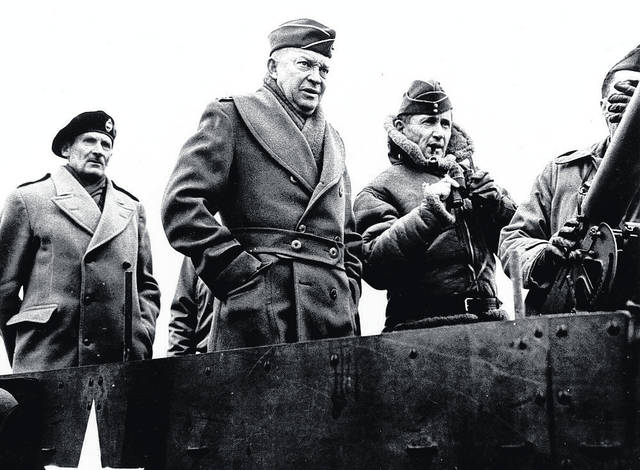
In this March 1944 file photo, U.S. World War II Gen. Dwight D. Eisenhower (center) as commander of the invasion of Europe is with British Air Chief Marshal Sir Arthur W. Tedder (center right) and British Field Marshal Bernard Montgomery.

The Brave, a monument dedicated to the American soldiers who landed on Omaha Beach on D-Day, stands on Omaha beach, in Normandy, western France.
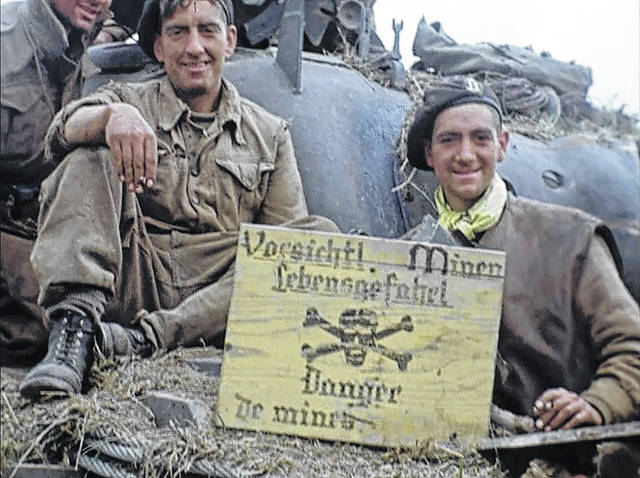
Soliders sit on a tank holding a sign about a mine field during World War II in France on June 6, 1944. Seventy-five years later, surprising color images of the D-Day invasion and aftermath have been rediscovered years after the death of Hollywood director George Stevens, who filmed them.
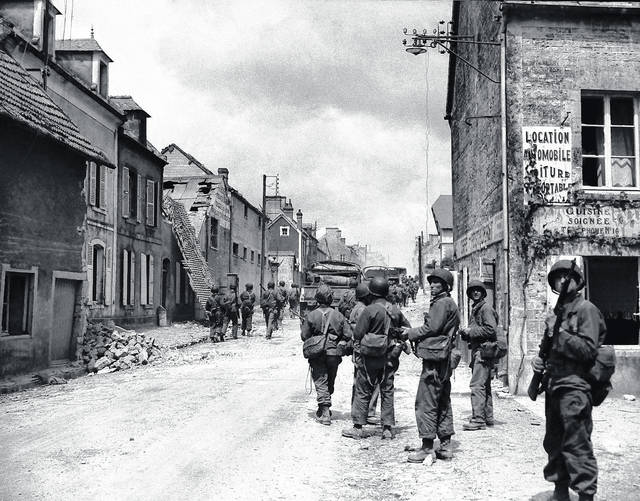
In this June 11, 1944, file photo, American paratroops patrol in the streets of Sainte-Mere-Eglise, France, before pushing on toward Cherbourg. About 15,000 paratroopers landed in and around the village not long after midnight on June 6, 1944, and seized it from the Germans by 4:30 a.m.
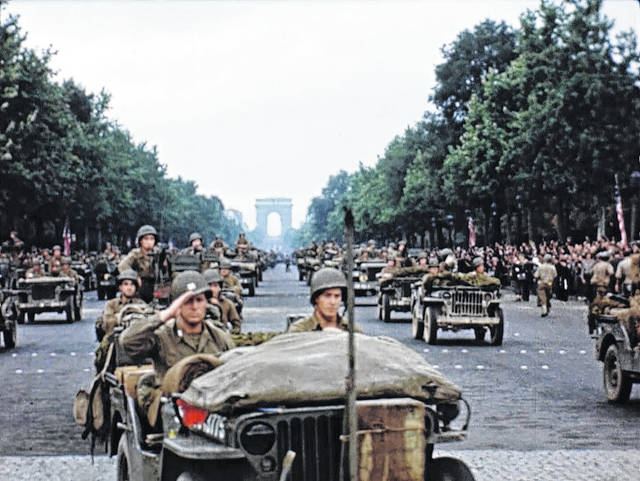
U.S. military vehicles and soldiers march down the Champs-Elysees after the liberation of Paris. Seventy-five years later, surprising color images of the D-Day invasion and aftermath have been rediscovered years after the death of Hollywood director George Stevens, who filmed them.
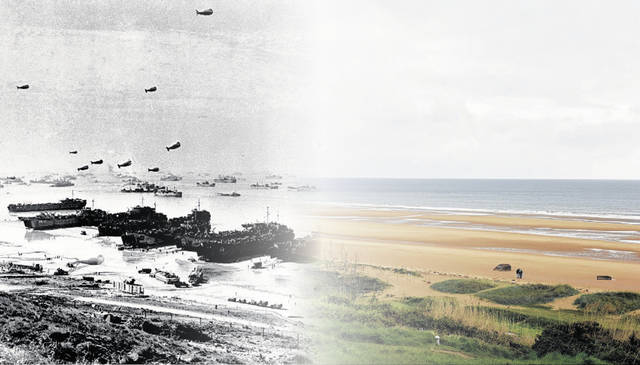
This combination of photos shows the scene along a section of Omaha Beach in June 1944, during Operation Overlord, the code name for the Allied invasion at the Normandy coast in France during World War II and a view of the same location on May 9.
